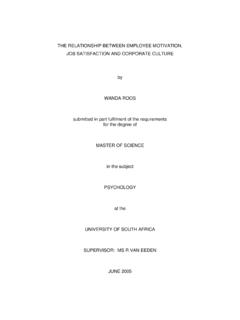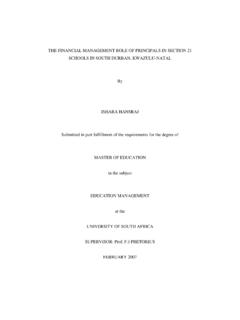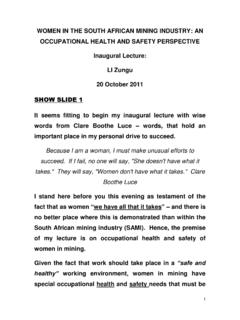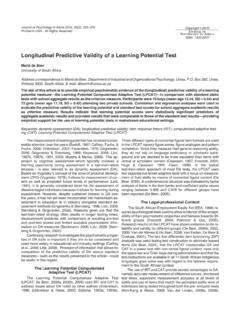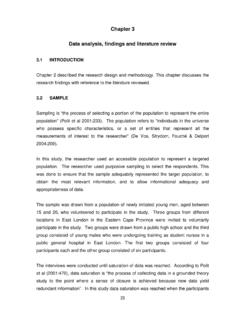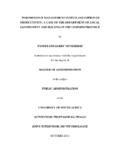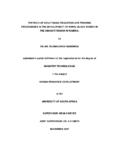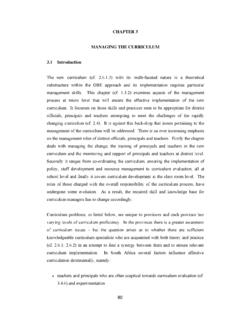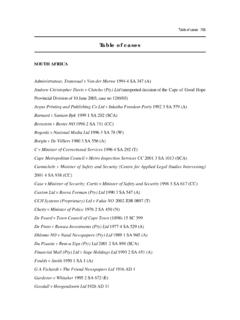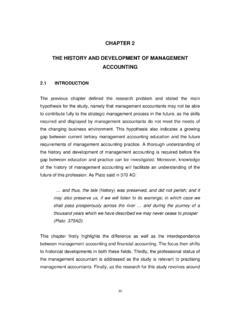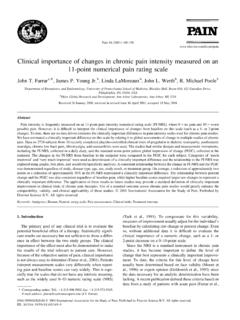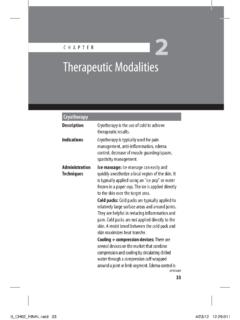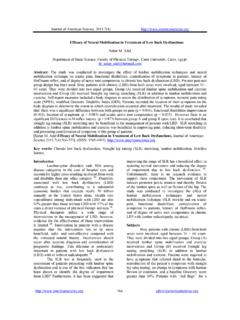Transcription of CHAPTER 3 Research design and methodology
1 38. CHAPTER 3. Research design and methodology INTRODUCTION. methodology and Research design direct the researcher in planning and implementing the study in a way that is most likely to achieve the intended goal. It is a blueprint for conducting the study (Burns & Grove 1998:745). This CHAPTER describes the Research design and methodology , including sampling and data collection and analysis. DEFINITION OF methodology . Mouton (1996:35) describes methodology as the means or methods of doing something. Polit and Hungler (1999:648) refer to it as the process of following the steps, procedures and strategies for gathering and analysing the data in a Research investigation. These methods describe in detail how the study was conducted. According to Burns and Grove (1998:581), methodology includes the design , setting, sample, methodological limitations and the data-collection and analysis techniques in a study.
2 This is the know-how of the scientific methods and techniques employed to obtain valid knowledge. Qualitative methodology is dialectic and interpretive. During the interaction between the researcher and the Research participant, the informant's world is discovered and interpreted by means of qualitative methods (De Vos 1998:242). In this study the researcher employed phenomenological methodology . Phenomenology is a science whose purpose is to describe particular phenomena, or the appearance of things, as lived experiences (Streubert & Carpenter 1999:43). However, phenomenological Research methodology is difficult to explain because it has no clearly defined steps. This is due, in part, to the reluctance of phenomenologists to place major emphasis on time or sequence of events.
3 Phenomenologists are of the opinion that the clear definition of methodology tends to limit researchers' creativity (Burns & Grove 1998:82). The concept phenomenology is described in section 39. LITERATURE REVIEW ON APPROACHES TO ASPECTS OF PAIN. Much Research has been conducted on different aspects of pain, such as the experience of general pain, labour pain and the cultural aspects in experiencing labour pain. Pain in general Various approaches have been adopted to investigate the aspect of pain in general. Vlaeyen, Pernot, Kole-Snijders, Schuerman, Van Eek and Groenman (1990:337) adopted a descriptive quantitative approach to study pain behaviour among patients with chronic pain. Beyer and Wells (1989:841) assessed pain in children by means of a descriptive quantitative approach, using pain measurement tools such as self-report measures, to describe pain.
4 Beyer and Wells utilised three types of measures to assess the pain experience, namely physiological, self-report and behavioural measures. Physiological variables are useful in examining the pain experience associated with short-term medical procedures, but there are no physiological responses that directly reflect patients' perception of pain. As self-report measures, Beyer and Wells used a pain experience history and a pain interview to facilitate the description of the pain experience as well as explain what the patients needed to be comforted. Behavioural measures involved observing the patients because the subjective state of suffering can only be known through observation of pain behaviour (Beyer & Wells 1989:840-841). In the present study, however, the researcher did not use observation as a Research method.
5 In a study of the history of pain management, Donovan (1989:257) found that over the centuries the knowledge and theories about pain have evolved through six stages. Beliefs and practices related to pain from all these stages continue to influence contemporary attitudes and practices regarding pain. Optimal pain control demands the integration of all that is known about pain into a holistic approach that benefits the patient experiencing pain. Labour pain In a study on labour pain, Jimenez (1996:53) adopted a descriptive phenomenological approach to establish a common vocabulary for exploring issues of pain and discomfort. The purpose of the study was to explore practice, Research and theory related to the management of pain and of discomfort in 40.
6 Childbearing women. Gibbins and Thompson (2001:304) also employed a phenomenological approach to study the expectations and experiences of women during labour. The purpose of utilising the phenomenological approach was to describe the meaning of an experience from the perspective of those involved in the experience. In this study, unstructured interviews were used to collect data, which allowed flexibility and made it possible for the researcher to follow the interests and thoughts of the participants. In a study on midwives' experiences with women and their pain during labour, Lundgren and Dahlberg (2002:155) adopted a phenomenological approach. The purpose of the study was to elicit the effect of support regarding the labour pain experience.
7 Holroyd et al (1997:66) utilised the Lazarus cognitive-phenomenological model of stress, appraisal and coping as a theoretical basis for their study of Hong Kong Chinese women's perception of support from midwives during labour. This provides a comprehensive basis for conceptualising the experience of labour. To study the psychological factors influencing personal control in pain care, McCrea et al (2000:493) used an exploratory Research design and methodology . Personal control was measured using a 36-item 7-point Likert scale. Measures of psychological factors included assessment of women's expectations of labour pain, maternal confidence, pain intensity, antenatal training and partner support. Cultural aspects of labour pain Machin and Scamell (1997:78) used ethnography to examine the experience of labour in a transcultural study.
8 Ethnographic Research gives a sense of the range of different experiences that women might have. Machin and Scamell (1997:82) used mainly participant and non-participant observation supplemented by tape-recorded, semi-structured interviews with each woman. Callister and Vega (1998:289) also used ethnography as a Research method to gain an insight into the cultural meanings of giving birth among Guatemalan women. Audio-taped interviews were conducted following an explanation of the study, its voluntary nature, and respondents' consent to participate. Choudhry (1997:533) adopted an ethnohistorical approach to study the traditional practices of women from India who had migrated to North America and Canada. Choudhry found that, as in all cultures, the women had certain beliefs about what facilitates a good pregnancy and its outcome, as well as negative sanctions.
9 Cultural beliefs and practices positively or negatively influenced the women's experience of labour pain. 41. Most of them preferred home delivery attended by a local, untrained midwife (dai) or by a birth attendant who was an experienced village woman. In an ethnographical study, Howard and Berbiglia (1997:665) found that stoic endurance of pain during labour was encouraged among Korean women because some believed that the samshin' goddess of three spirits dislikes the screaming, or is simply embarrassed about the situation of delivery. Khalaf and Callister (1997:373) conducted a descriptive, ethnographic study on the experiences of childbirth for Muslim women living in Jordan. Khalaf and Callister interviewed thirty-two women in the early postpartum weeks and identified the women's motivation for having children, what constitutes motherhood, and the importance of relying on God or Allah for support in bearing and rearing children.
10 Khalaf and Callister also identified a strong sense of the spiritual dimensions of giving birth within the women's traditional, religious, and cultural context. Chesney (1998:57) made use of ethnographic/oral history to study dilemmas of interviewing women who had given birth in Pakistan. Unstructured interviews, participant observation and an autobiography, written as a reflective diary were used. Callister (1992:50-52) adopted a phenomenological approach to investigate the meaning of the childbirth experience for Mormon women. A non-probability sample of 26 primiparous mothers who had uncomplicated vaginal births of healthy full-term infants participated in the interviews conducted in their homes within two weeks of giving birth. Finn (1994:25) used phenomenology to study culture care of Euro-American women during labour and childbirth, using Leininger's sunrise model.
